Writing a well-designed resume cover letter is an easy way to effectively present yourself as a professional and to show your personality. The purpose of a resume is to provide the employer with specific facts from your professional background, while a cover letter is a written introduction to your personality. It expands on the “dry” information briefly presented in summary. A cover letter allows the hiring manager and supervisor to know you better. It allows you to form an opinion about yourself and your achievements, motivation, goals, and readiness to take a position. It also explains why you are suitable for the advertised vacancy, even before reading the facts from the CV in detail. Like a resume, a cover letter needs to be tailored to the company you want to join.
Parts of a Letter
Let’s look at the components of a cover letter, and what each part includes.
Header
The title must contain contact information:
- Name and surname.
- Phone number.
- Email address.
- Postal/mailing address (only in some cases).
- Links to a portfolio or social networks (if specifically required by the position).
It is important to put this information at the beginning, in one of the corners of the cover letter, in a place easily accessible to the recruiter. A huge plus will be the unity of the style of the resume and letter. To do this, you can use one of the templates from the Internet or create your unique one.
Greeting
At this stage, you have the first opportunity to demonstrate an interest in the company. If you’re writing to a hiring manager, try to get their name to direct it specifically to them (look in the job description or on the company’s website). A letter addressed directly to your future boss should also begin with their name. In greeting, you can use the appropriate titles and honorifics. For example, start with “Dear (Mr./Ms.)” to credit the person the letter is addressed to.
Introduction
The answer to the question “Why should you get this position?” goes in the first paragraph. Be sure to include the title of the job itself, as there may be many of them in the company. Tell us about yourself, why you are suitable for a particular position in this company – present yourself. Explain that you are the person the company is looking for. In some cases, it is appropriate to talk about exactly how you found out about the job – especially if it was recommended to you by someone associated with the company. It will be an asset to explain why you decided to apply to this particular company. For example, if you like the company’s products/goods/services, corporate ethics, or approach to tasks, write about this. This is a great strategy to achieve your goal.
Qualifications
Write a brief analysis of your level of qualification – describe how the work experience you already have makes you suitable for the position and how these acquired skills will make you a better employee. It will not be superfluous to list projects and situations that demonstrate your ability to solve problems and tasks. If you have played an important role in the effectiveness of any project, do not forget to mention it.
Values and Goals
Remember that in this case, you should carefully consider the aspirations and values of the company, comparing them with your own. The employer wants to see that you understand and share their worldview. This also includes elements of corporate culture that you like. This section will show how harmoniously you “fit” into the team.
Call to action
The call to action is where you thank the reader for their attention and express your hope and desire to continue the dialogue. You can talk about how your presence in the team will affect the workflow. Demonstrate an ardent desire to receive an interview or test task invitation.
Signature
Sign at the end of the letter. To do this, you can use words and phrases such as:
- “Best wishes.”
- “Sincerely.”
- “Thank you.”
Sometimes a signature is automatically added to e-mail – make sure that it is not there or matches with the information you have presented about yourself.
Cover Letter Examples
Depending on the career position of the candidate, the cover letter will have different key features. It should reflect the current level of the specialist and demonstrate the value in this position. Let us briefly consider the main points of each of the categories with examples.
Cover Letter Example for Middle Management
Cover Letter Example for Middle Management
In the beginning, the contact details of the recruitment manager are indicated – this is how attention to the vacancy and the company is shown. Mid-level specialists need to emphasize their work experience. This is evidenced by the mention of 11 years of experience in the first paragraph – for such a long time, many valuable skills are acquired, which are described in the second section. The letter ends with gratitude for the attention – this shows that a person appreciates the time of his superiors.
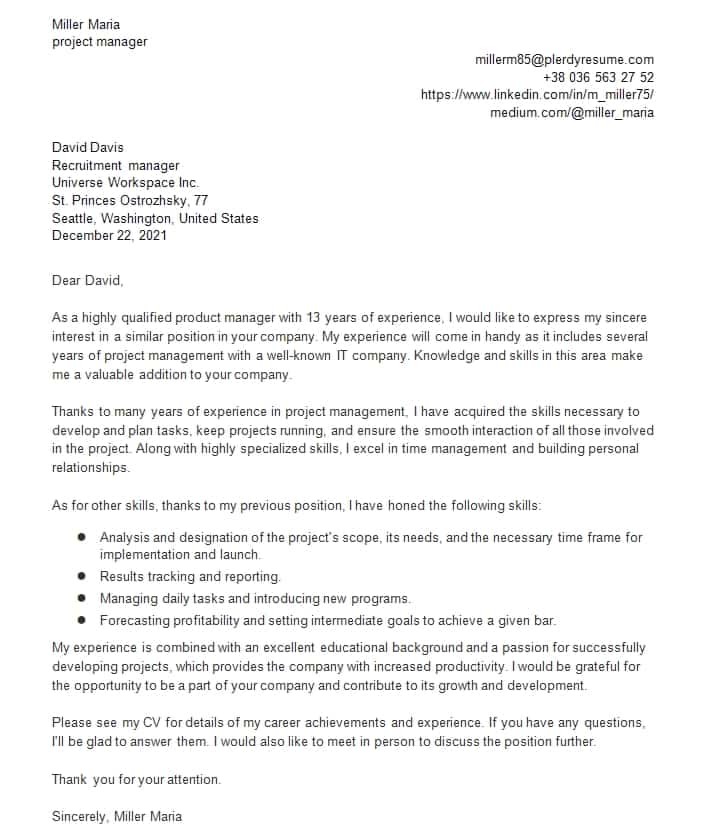
Cover Letter Example for Management
Cover Letter Example for Management
A good leader can give a lot to a company. When searching for a candidate for this position, managers first look for someone who already knows what to bring to the company and is ready to act actively. This is exactly the attitude reflected in the cover letter below – with the help of a bulleted list, the reasons why the candidate’s experience deserves attention are listed. Next, candidate Clara Lucila focuses on her soft skills as a leader, which is essential in such a position. The final paragraph reads confidence and determination.
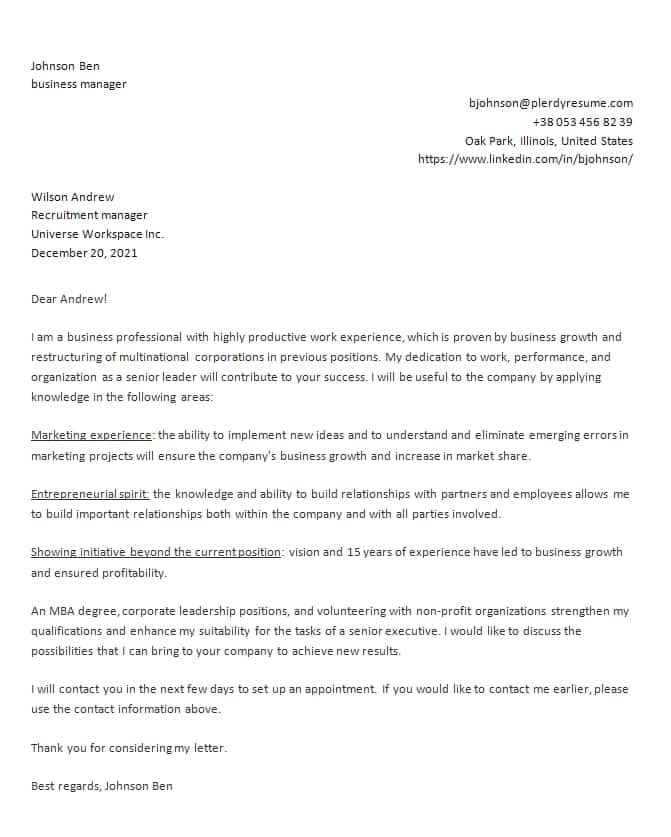
Cover Letter Example for a Ph.D. Application
Cover Letter Example for a PhD Application
An applicant for a place in the Ph.D. program must show their interest, qualities in training, and active work. The sections of the example describe each of these points in turn. So, in the first paragraphs, attention is paid to the professional level; specific courses of interest and goals are listed. Then we talk about success in learning: it is emphasized that not a single exam was “fluffed up.” A mandatory item in this type of cover letter is a description of political, social, and volunteer activities.
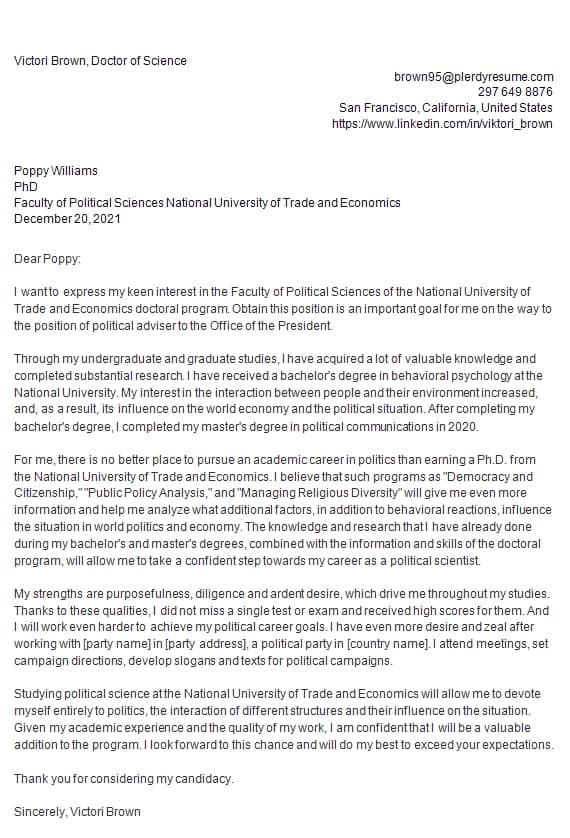
Professional Cover Letter Example
Professional Cover Letter Example
A cover letter from a top-level specialist reflects his professionalism. Here is a good example – in the second paragraph, the achievements in the previous job are specifically described. And in the third, with the help of a list, it is shown how the acquired skills will help in future activities. Moreover, we are talking about the skills of a manager as a member of the work team and human qualities – ethics, leadership, and positive thinking.
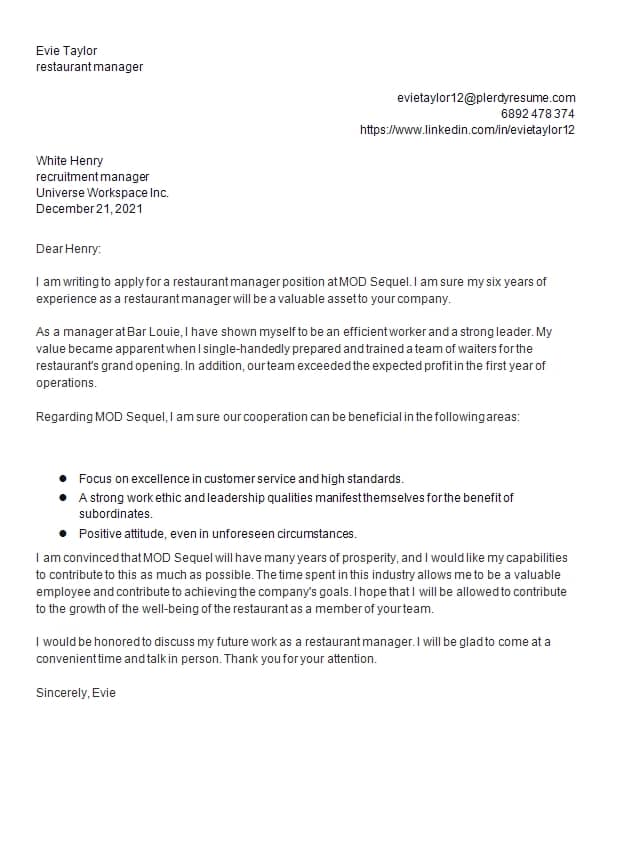
Career Change Cover Letter Example
Career Change Cover Letter Example
Consider a few points when changing careers with no work experience in the desired position. In the example, they are expressed like this:
- First, the previous position is indicated, and confidence is expressed that the skills will help one become a highly qualified specialist in the new field.
- The following section is devoted to the company – interest, a sincere desire to work in it play an important role. Highlight this point.
- The third paragraph shows how the accomplishments and responsibilities of being a marketer will help the new company.
The letter ends with a polite, but at the same time, persistent expression of hope for further cooperation.
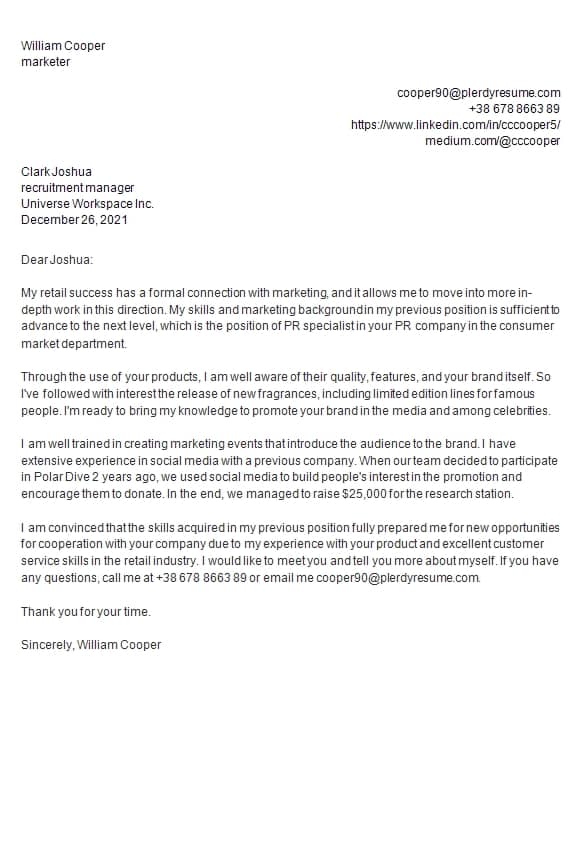
Cover Letter Example for Senior Executive
Cover Letter Example for Senior Executive
The vice president or other senior management position implies a long track record of accomplishments. This is what you need to show in your cover letter. The example clearly shows that all the facts are confirmed by specific figures – experience, development success, handling large sums, and increasing the team’s productivity as a percentage. This information is important because it makes a specialist valuable to the company.
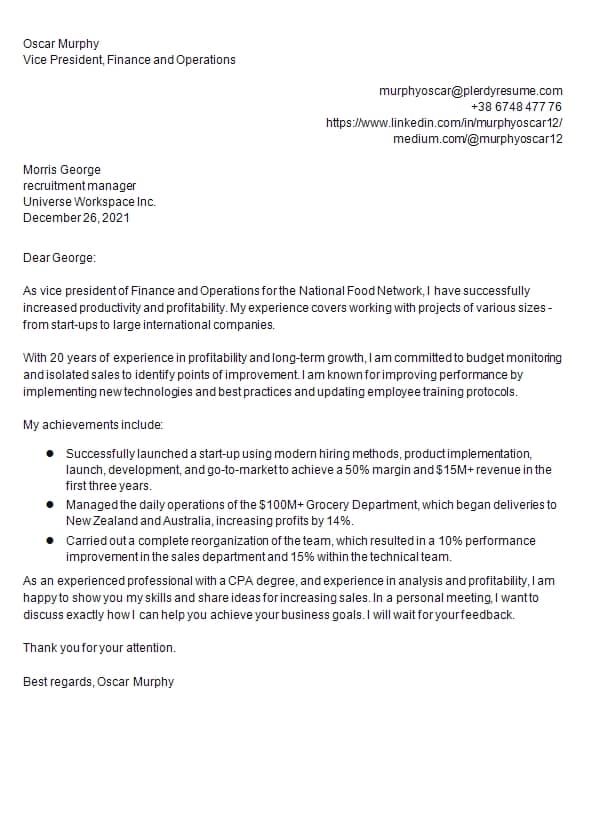
Conclusion
A cover letter is an excellent opportunity to stand out from other candidates. Often it becomes a decisive factor in hiring. A properly drafted document can significantly increase your chances of getting your dream job.
